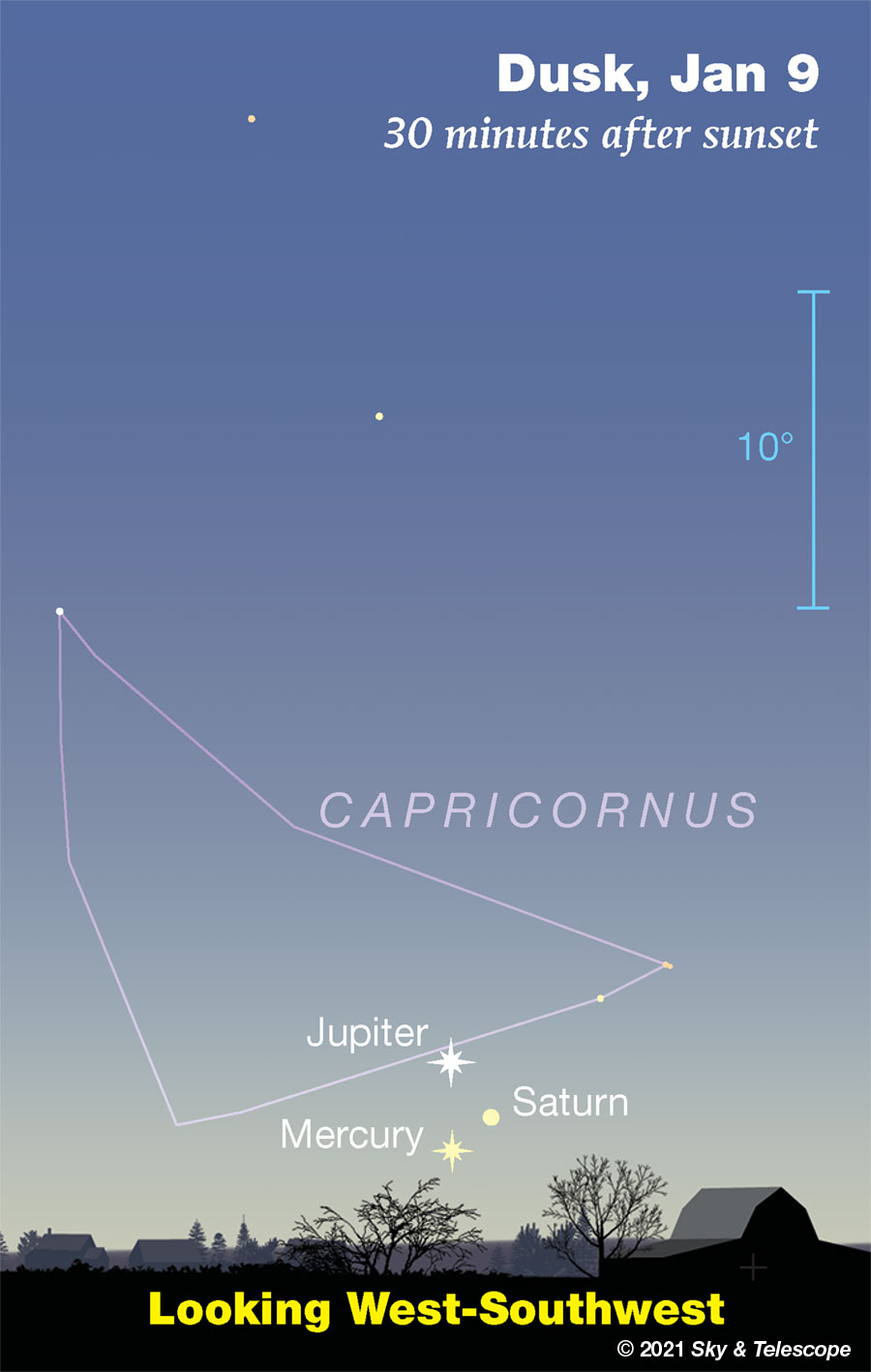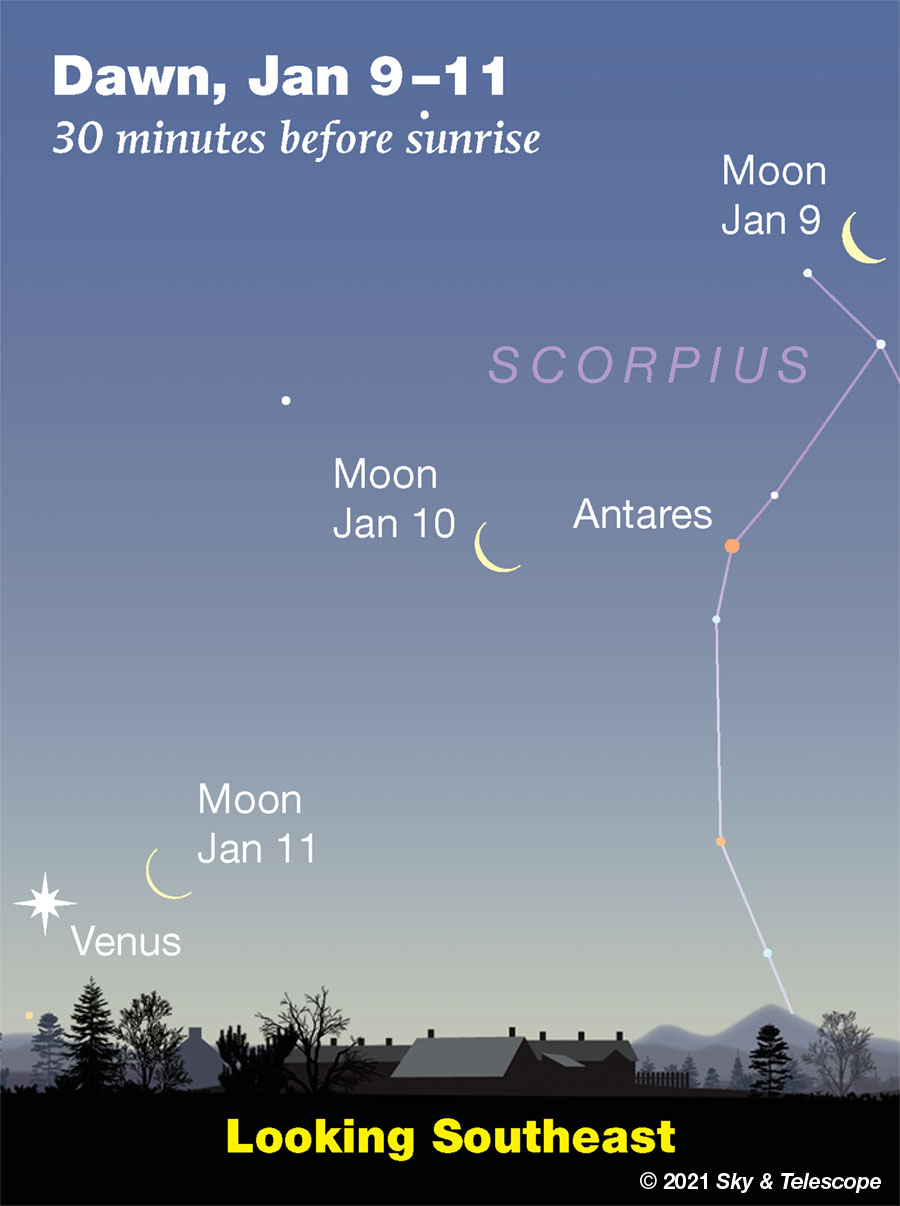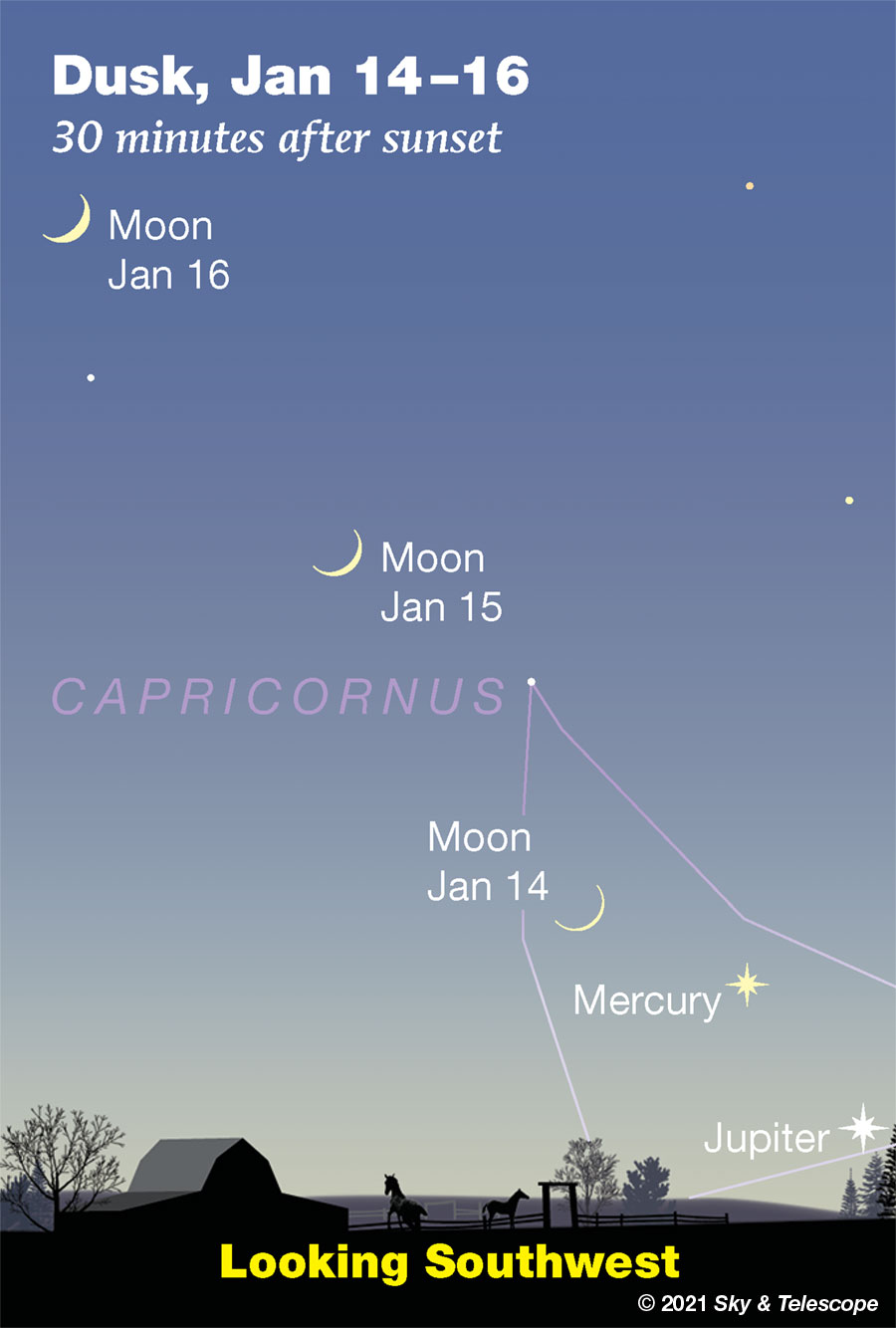FRIDAY, JANUARY 8
■ If your sky is even moderately dark, try to trace out the winter Milky Way arching across the sky. In early evening it extends up from the west-northwest horizon along the vertical Northern Cross of Cygnus, up and over to the right past dim Cepheus and through Cassiopeia high in the north, then to the right and lower right through Perseus and Auriga, down between the feet of Gemini and Orion's Club, and on down to the east-southeast horizon between Procyon and Sirius.
SATURDAY, JANUARY 9

■ Twilight challenge: the planet-conjunction finale. Jupiter and especially fainter Saturn are becoming ever harder to pick up low in bright twilight, but bring those binoculars for a look this evening. Because now they are three! Mercury is emerging to pass them, on its way up toward its good evening apparition later this month.
You'll pick up Jupiter first: it's brightest at magnitude –1.9. Mercury is –0.9, and Saturn is a feebler +0.6.
This evening the triangle they form is 3° tall (at twilight in North America) as shown above. For the next three days, Mercury will step toward the upper left past the other two. Tomorrow the 10th they will form a tighter, roughly equilateral triangle about 2° on a side.
SUNDAY, JANUARY 10
■ Compared to the scene above, Mercury has moved a little to the upper left to form, with Jupiter and Saturn, a tighter, roughly equilateral triangle only about 2° on a side.
■ After dinnertime in this coldest time of the year, the dim Little Dipper (Ursa Minor) hangs straight down from Polaris, as if, per Leslie Peltier, from a nail on the cold barn wall of the northern sky.
The Big Dipper, meanwhile, creeps up low in the north-northeast. Its handle is very low and its bowl is to the upper right.
■ As dawn brightens about a half hour before Monday's sunrise, look very low in the southeast for Venus. The thin crescent Moon is about 4° to its right (for North America), as shown below. Binoculars will help.

MONDAY, JANUARY 11
■ Now Mercury shines 1.5° to the left or lower left of Jupiter low in bright twilight. Dimmer Saturn is 2.4° to Jupiter's lower right and is becoming hard to see even with binoculars.
■ After dinnertime now, the enormous Andromeda-Pegasus complex runs from near the zenith far down to the west. Near the zenith, spot Andromeda's high foot: 2nd-magnitude Gamma Andromedae (Almach), slightly orange. Andromeda is standing on her head. Her head-star (2nd-magnitude Alpheratz) is the top corner of the Great Square of Pegasus. Down from the Square's bottom corner run the stars outlining Pegasus's neck and head, ending at his nose: 2nd-magnitude Enif, also slightly orange.
TUESDAY, JANUARY 12
■ Here it is the coldest very bottom of the year, but the Summer Star, Vega, is still barely hanging in there. Look for it twinkling over the northwest horizon during and just after nightfall. The farther north you are the higher it will be. If you're as far south as Florida, it's already gone.
■ New Moon (exactly so at 12:00 midnight tonight EST).
WEDNESDAY, JANUARY 13
■ In this dark-of-the-Moon time, take advantage of the sparking winter nights to explore telescopic sights in Taurus high overhead using the charts and photos with Ken Hewitt-White's "Suburban Stargazer" column in the January Sky & Telescope, page 54. Some of them you may well know (think Crab Nebula), but I bet some will be new to you.
■ And not far away near Capella, poke around for new telescopic sights using Bob King's Foraging for Deep-sky Delights with Capella, the Goat Star (with chart). Most of these will require a big scope, but not the double star Struve 669 just 0.8° south-southeast of Capella. Its components are magnitudes 8.4 and 9.0, 10 arcseconds apart, oriented east-west. "At 64× the pair resembles Jupiter and Saturn during their recent Great Conjunction," says Bob, but as if seen from very far away.
THURSDAY, JANUARY 14

■ In bright twilight, look low in the southwest for the thin crescent Moon aiming its curve lower right toward Mercury and disappearing Jupiter, as shown above.
■ Above Orion shines orange Aldebaran with the large, loose Hyades cluster in its background. Binoculars are the ideal instrument for the Hyades given the group's size: its brightest stars (4th and 5th magnitude) span about 4°. (The Pleiades higher above are hardly more than 1° across counting just the brightest stars.)
The main Hyades stars famously form a V. It's currently lying on its side, and Aldebaran forms the lower left tip of the V. With binoculars, follow the lower branch of the V to the right from Aldebaran. The first thing you come to is the House asterism: a pattern of stars like a child's drawing of a house with a peaked roof. The house is currently upright and bent to the right like it got pushed.
The House includes three easy binocular double stars that form an equilateral triangle, with each pair facing the others. The brightest pair is Theta1 and Theta2 Tauri. You may find that you can resolve the Theta pair with your unaided eyes.
FRIDAY, JANUARY 15
■ The crescent Moon in the southwest after sunset is higher and easier to spot now. It still aims its curve down toward Mercury, as shown above. Farther down, will binoculars help to pick out Jupiter in its very narrow time window of visibility?
SATURDAY, JANUARY 16
■ Zero-magnitude Capella high overhead, and equally bright Rigel in Orion's foot, have almost the same right ascension. This means they cross your sky’s meridian at almost exactly the same time: around 9 or 10 p.m. now, depending on how far east or west you live in your time zone. (Capella goes exactly through your zenith if you're at latitude 46° north: Portland, Oregon; Montreal; central France.)
So, whenever Capella passes its very highest, Rigel always marks true south over your landscape, and vice versa.
This Week's Planet Roundup
Mercury is hidden deep in the glow of sunset for much of the week. But by January 9th it joins Jupiter and Saturn very low in the southwest in bright twilight. See the top of this page, above. Bring binoculars.
Venus (magnitude –3.9) is very low in the southeast as dawn grows bright.
Mars (magnitude 0.0, in Aries) shines pale yellow-orange at its highest in the south right after nightfall. Mars continues to fade and shrink into the distance. It's now 10 or 9 arcseconds wide in a telescope, maybe still enough to show some large-scale surface markings during steady seeing. It's gibbous, 89% sunlit from Earth's point of view.
To get a map of the side of Mars facing you at the date and time you observe, you can use our Mars Profiler. The map there is square; remember to mentally wrap it onto the side of a globe. (Features near the map's edges become very foreshortened.)
Jupiter and Saturn (magnitudes –1.9 and +0.6, respectively) are very low in the southwest in bright twilight and getting lower every day. Jupiter is the bright one. Saturn, a little more than 2° to Jupiter's lower right, is only a tenth as bright. How long into 2021 can you keep them in view?
Uranus (magnitude 5.7, in Aries) is high in the south in early evening, roughly 5° east (left) of Mars. Uranus is only 3.7 arcseconds wide, but that's enough to appear as a tiny fuzzy ball, not a point, at high power in even a smallish telescope with sharp optics — during spells of good seeing.
Neptune (magnitude 7.9, in Aquarius) is getting low in the southwest right after dark. Neptune is 2.3 arcseconds wide, harder to resolve than Uranus except in very good seeing. Finder charts for Uranus and Neptune.
All descriptions that relate to your horizon — including the words up, down, right, and left — are written for the world's mid-northern latitudes. Descriptions that also depend on longitude (mainly Moon positions) are for North America.
Eastern Standard Time, EST, is Universal Time minus 5 hours. (Universal Time is also known as UT, UTC, GMT, or Z time.)
Want to become a better astronomer? Learn your way around the constellations. They're the key to locating everything fainter and deeper to hunt with binoculars or a telescope.
This is an outdoor nature hobby. For an easy-to-use constellation guide covering the whole evening sky, use the big monthly map in the center of each issue of Sky & Telescope, the essential magazine of astronomy.
Once you get a telescope, to put it to good use you'll need a detailed, large-scale sky atlas (set of charts). The basic standard is the Pocket Sky Atlas (in either the original or Jumbo Edition), which shows stars to magnitude 7.6.

Next up is the larger and deeper Sky Atlas 2000.0, plotting stars to magnitude 8.5; nearly three times as many. The next up, once you know your way around, are the even larger Interstellarum atlas (stars to magnitude 9.5) or Uranometria 2000.0 (stars to magnitude 9.75). And be sure to read how to use sky charts with a telescope.
You'll also want a good deep-sky guidebook, such as Sky Atlas 2000.0 Companion by Strong and Sinnott, or the bigger (and illustrated) Night Sky Observer's Guide by Kepple and Sanner.
Can a computerized telescope replace charts? Not for beginners, I don't think, and not on mounts and tripods that are less than top-quality mechanically, meaning heavy and expensive. And as Terence Dickinson and Alan Dyer say in their Backyard Astronomer's Guide, "A full appreciation of the universe cannot come without developing the skills to find things in the sky and understanding how the sky works. This knowledge comes only by spending time under the stars with star maps in hand."
![]() Audio sky tour. Out under the evening sky with your
Audio sky tour. Out under the evening sky with your
earbuds in place, listen to Kelly Beatty's monthly
podcast tour of the heavens above. It's free.
"The dangers of not thinking clearly are much greater now than ever before. It's not that there's something new in our way of thinking, it's that credulous and confused thinking can be much more lethal in ways it was never before."
— Carl Sagan, 1996
"Facts are stubborn things."
— John Adams, 1770
 14
14









Comments
Rod
January 8, 2021 at 10:50 am
Saturday's event for Jupiter, Mercury, and Saturn looks like fun to view using 10x50 binoculars. I checked Stellarium and Starry Night for my location. Visible about 1730 EST but very low, some 4 to 7 degrees above the horizon in SW near 237-238 degrees azimuth. At my location, weather has been mostly cloudy, sometimes light rain, light snow but looks better for some stargazing tomorrow evening perhaps at my location.
You must be logged in to post a comment.
New Jersey Eclipse Fan
January 8, 2021 at 4:08 pm
Yeah, cloudy here all day in Central Jersey, too. But clear skies predicted for Saturday! Thanks, Rod.
You must be logged in to post a comment.
TenOfSwords
January 9, 2021 at 8:51 am
I live in Central Jersey as well - and I'm looking ahead to the Mars-Uranus conjunction on the 21st, which will be much higher to spot. I've never seen Uranus in my life - but this time the much-brighter Mars should provide a convenient "jumping-off point" to view it with binoculars (mine are 6-18X30).
You must be logged in to post a comment.
New Jersey Eclipse Fan
January 9, 2021 at 10:53 pm
That makes two of us! Thanks for the heads "up."
You must be logged in to post a comment.
Rod
January 11, 2021 at 2:18 pm
NJECF, interesting. There were some 4th-5th magnitude stars near 2:00 position of Jupiter within 2 degrees or less. I checked using Stellarium and Starry Night for Trenton NJ location at 1745 EST. Some other stars show lower than Jupiter near Mercury position but these are some 7th magnitude.
You must be logged in to post a comment.
Rod
January 10, 2021 at 8:54 am
FYI. I did observe some of the Mercury, Saturn, and Jupiter show yesterday evening. Clear, cold at my location. I was in a 50-acre horse farm field (neighbor) next to my place viewing with 10x50 binoculars from 1650-1750 EST. Sunset near 1704 EST. By 1723 EST I could see Jupiter and Mercury but Saturn still to faint for the binoculars because of sky glow after sunset. Mercury and Saturn were dipping behind some distant freeline though so I never observed Saturn, Jupiter still. It was a great evening though. Flocks of geese flew over me heading home after sunset, deer were nearby in the fields, and in another location a deer hunter took a shot :)----Rod
You must be logged in to post a comment.
Rod
January 10, 2021 at 8:56 am
FYI, *freeline* is a tree line off in the distance 🙂
You must be logged in to post a comment.
New Jersey Eclipse Fan
January 11, 2021 at 12:39 am
Sunday evening I borrowed my son's binoculars--which are also 10x50! I went to a nice, flat-horizon location nearby, the same one where I viewed Comet NEOWISE. Sunset here was 4:50pm and I viewed the Western skies from 5:35-5:50. Jupiter was easy to spot, I had to wait awhile before viewing Saturn and I think I saw Mercury. I say that because there were two heavenly bodies in the same area beneath and slightly to the left of Jupiter and I'm not sure which one it was. Do you know what else I was looking at?
You must be logged in to post a comment.
mary beth
January 11, 2021 at 10:49 pm
One was definitely mercury and on Stellarium, I couldn’t find anything else that was big enough to be named in that area, beside mercury. So not sure what the other one would be....Was hoping Rod would answer
You must be logged in to post a comment.
New Jersey Eclipse Fan
January 12, 2021 at 3:45 pm
Thanks. As the lyrics from the Bee Gees' "Nights on Broadway" goes:
I will wait
Even if it takes forever
I will wait
Even if it takes a lifetime
You must be logged in to post a comment.
mary beth
January 14, 2021 at 5:06 pm
Looking that way lol
You must be logged in to post a comment.
Rod
January 11, 2021 at 2:21 pm
FYI. I enjoyed some time out last night after sunset until near 19:00 EST using my 90-mm refractor and 10-inch Newtonian. Enjoyed views of Mars, Uranus, and M45, the Pleiades. Always fun with a bigger telescope and good to compare views. Low power evening 35x to 40x views with wider field. Mars is slowly getting closer to Uranus now, 20-21 of this month close to 1.5 degree angular separation in their sky positions. In the 10-inch view using my 2-inch eyepiece, Mars was indeed quite bright but many faint stars scattered around the field, some 9th-11th magnitude or fainter. Very nice view.
You must be logged in to post a comment.
mary beth
January 11, 2021 at 2:37 pm
Rod, NJEF, et al.... New Year Greetings! We had a pretty cloudy week but I believe we are going to have a clear sky tonight. Looking forward to the crescent moon later this week and to be able to see Orion. Hope everyone is staying healthy and having a pretty good start to the new year!
You must be logged in to post a comment.
New Jersey Eclipse Fan
January 11, 2021 at 2:48 pm
Thanks and same to you. Anybody know the answer to my question above?
You must be logged in to post a comment.
You must be logged in to post a comment.